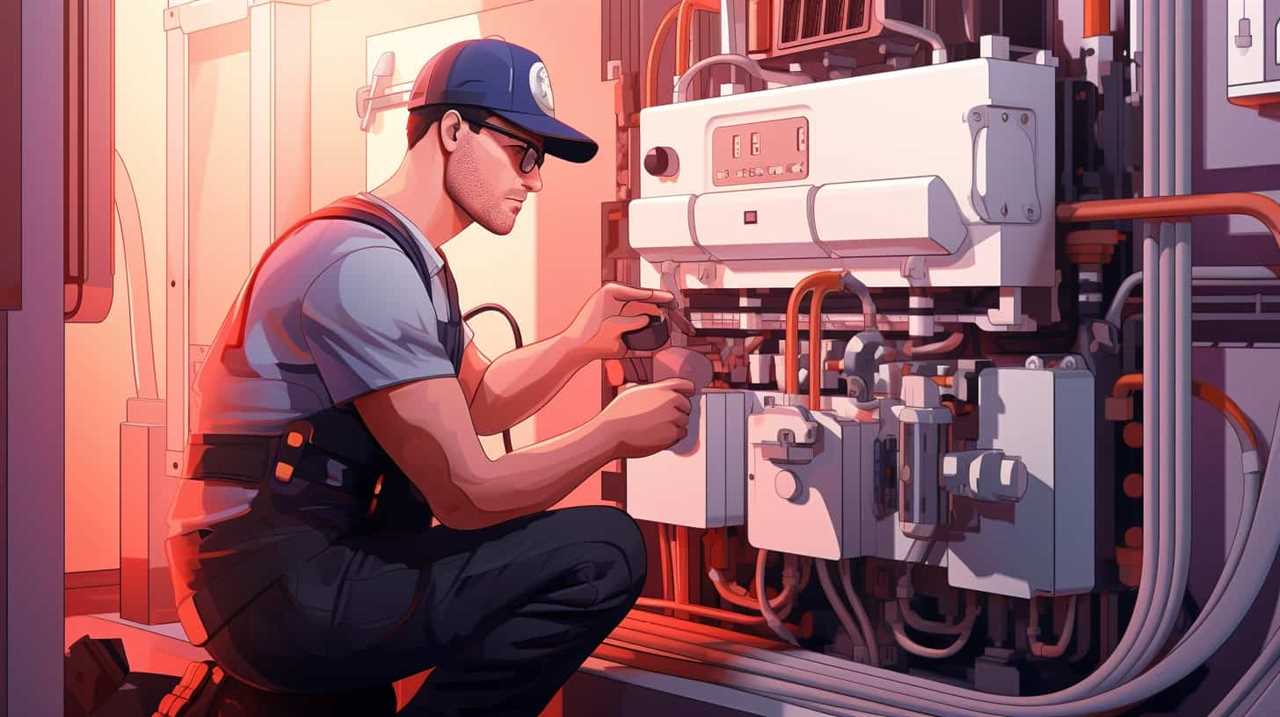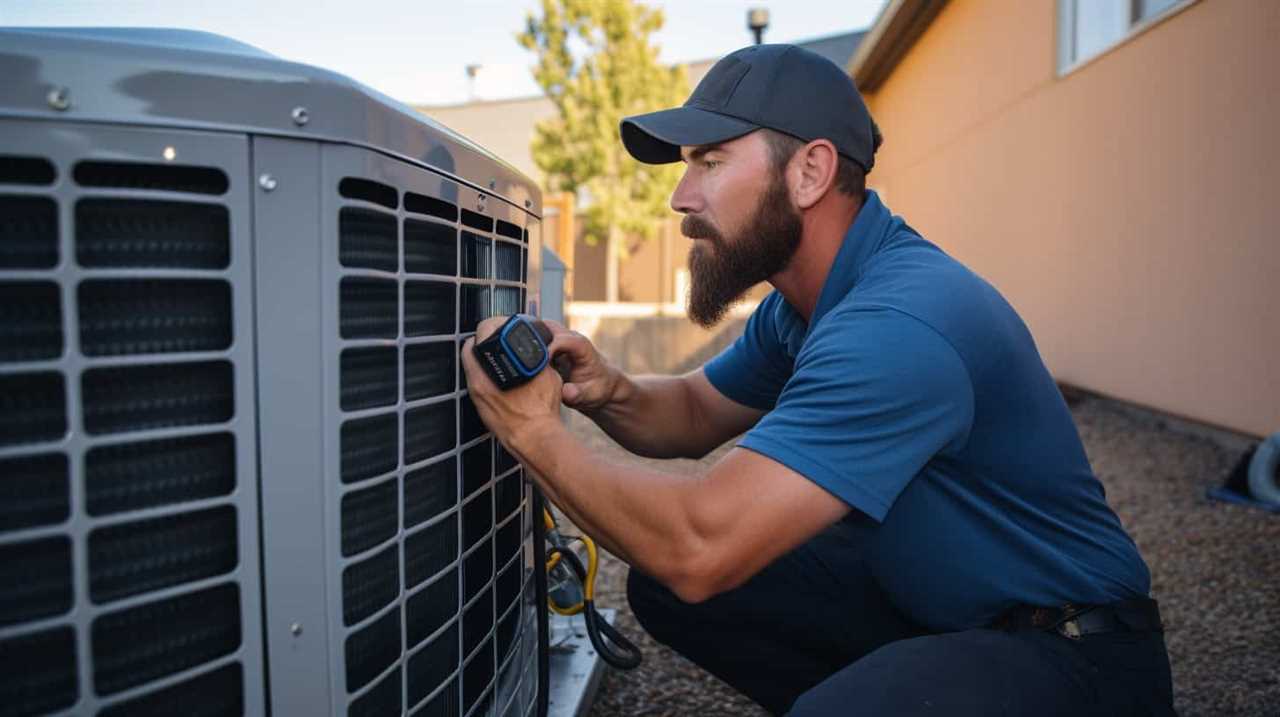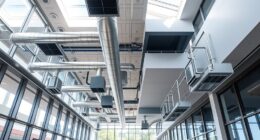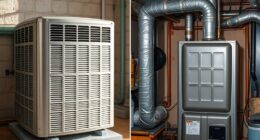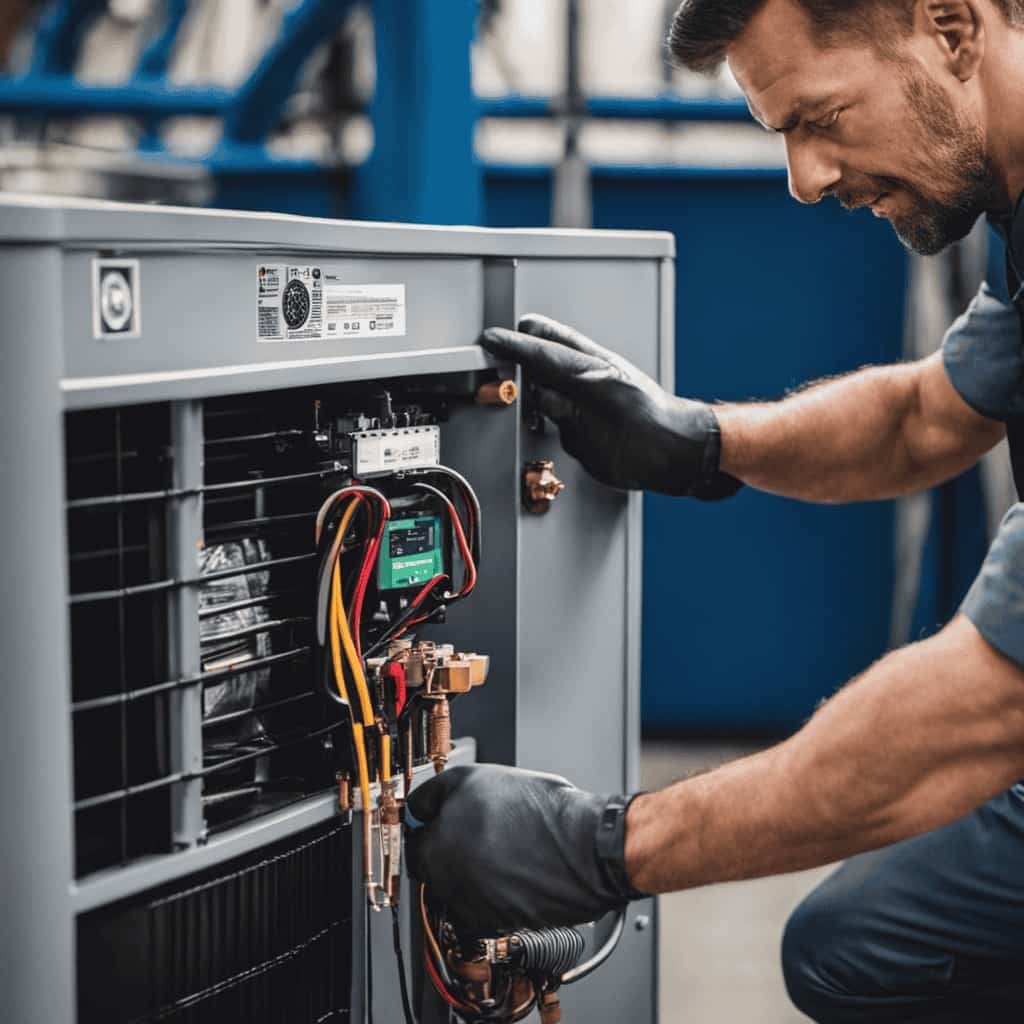
Fed up with soaring energy costs and ineffective heating solutions? Search no more! We present 15 effective tactics to enhance your heat pump’s efficiency and cut down on your expenses.
From understanding efficiency ratings to incorporating renewable energy sources, we’ve got you covered. With proper sizing, installation, and regular maintenance, you can optimize airflow and choose the right heat pump model for your needs.
Don’t wait – start saving today!
Key Takeaways
- Choosing a heat pump with high SEER and HSPF ratings ensures energy savings and lower utility bills.
- Proper sizing and installation techniques are crucial for maximizing heat pump efficiency.
- Regular maintenance by professionals and DIY cleaning tips enhance the performance and efficiency of the heat pump.
- Upgrading and optimizing with programmable thermostats, airflow and ventilation improvements, zone control systems, and insulating ductwork can significantly boost heat pump efficiency.
Understanding Heat Pump Efficiency Ratings
We will begin by explaining the importance of understanding heat pump efficiency ratings.
Proper maintenance techniques and energy saving tips are crucial for optimizing the efficiency of heat pumps.
Heat pump efficiency ratings indicate how effectively a heat pump can convert energy into heat or cool air. The ratings are expressed as a Seasonal Energy Efficiency Ratio (SEER) for cooling and a Heating Seasonal Performance Factor (HSPF) for heating. SEER measures the cooling efficiency of the heat pump, while HSPF measures the heating efficiency.
It’s essential to choose a heat pump with a high SEER and HSPF rating to ensure energy savings and lower utility bills.
Regular maintenance, such as cleaning or replacing air filters, checking refrigerant levels, and inspecting the outdoor unit, can also enhance the heat pump’s performance and efficiency.
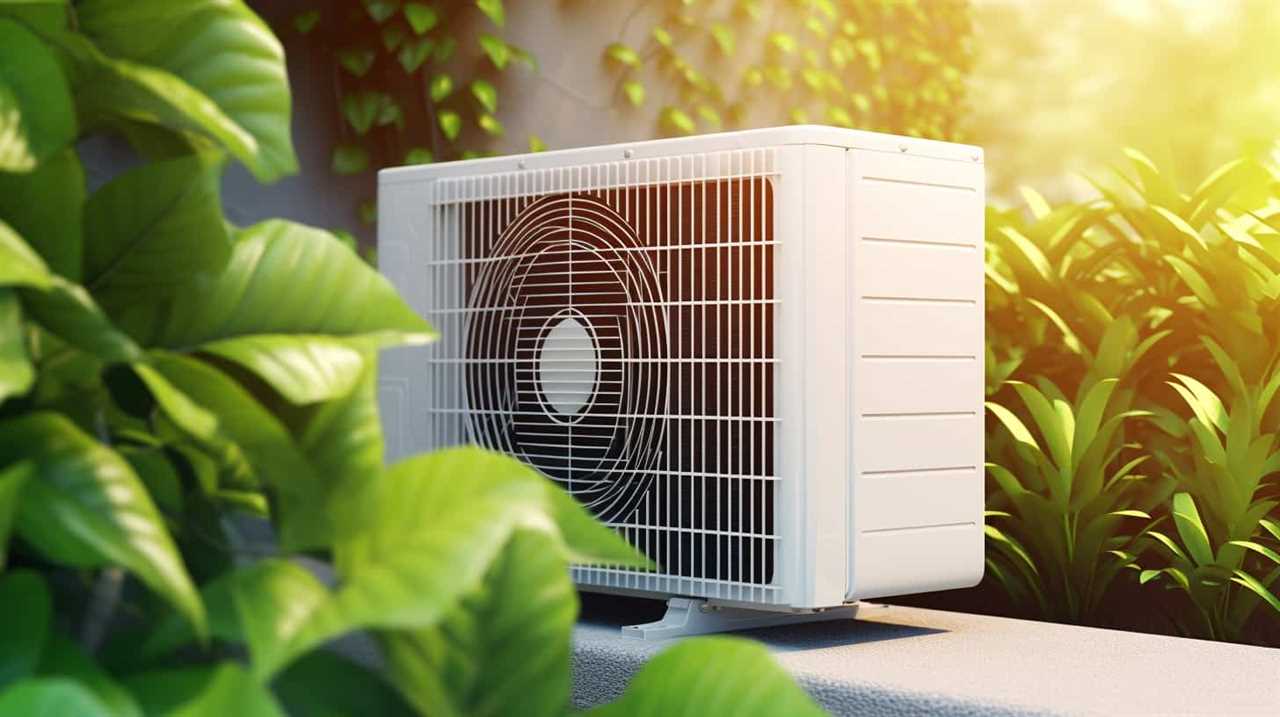
Proper Sizing and Installation Techniques
When it comes to heat pump efficiency, correct sizing and proper installation techniques are crucial. By ensuring that the heat pump is sized appropriately for the space it needs to heat or cool, we can maximize its efficiency and performance.
Additionally, using the right installation methods, such as proper insulation and sealing, can further enhance the heat pump’s efficiency by minimizing heat loss or gain.
Proper sizing and installation techniques go hand in hand in achieving optimal heat pump efficiency, resulting in energy savings and improved comfort.
Importance of Correct Sizing
Correctly sizing and installing heat pumps is crucial for maximizing efficiency and should always be done with careful consideration and attention to detail. The benefits of correct sizing are numerous.
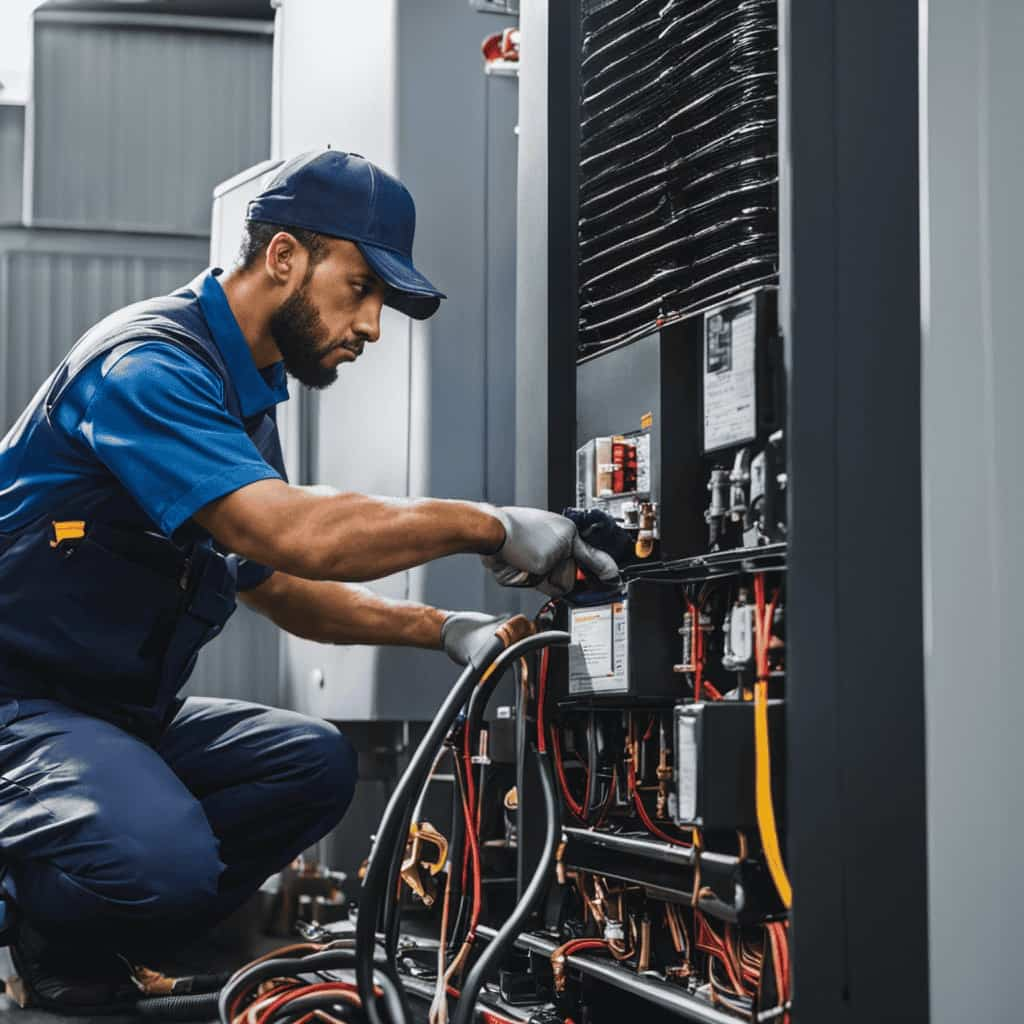
Firstly, it ensures that the heat pump operates at its optimal efficiency level, reducing energy consumption and lowering utility bills. Oversized systems tend to short cycle, resulting in frequent starts and stops, which can wear out components more quickly and decrease the overall lifespan of the unit. On the other hand, undersized systems may struggle to meet the heating or cooling demands of the space, leading to discomfort for occupants.
Additionally, proper installation techniques are equally important. This includes ensuring proper airflow, sealing ductwork, and proper refrigerant charge. These installation techniques contribute to improved heat pump performance and longevity, ensuring that the system operates efficiently for years to come.
Proper Installation Methods
To ensure optimal efficiency and performance, it’s crucial to properly size and install heat pumps using the appropriate techniques. By following proper installation methods, you can maximize the efficiency of your heat pump and improve its overall performance.
Here are three key installation techniques to consider:
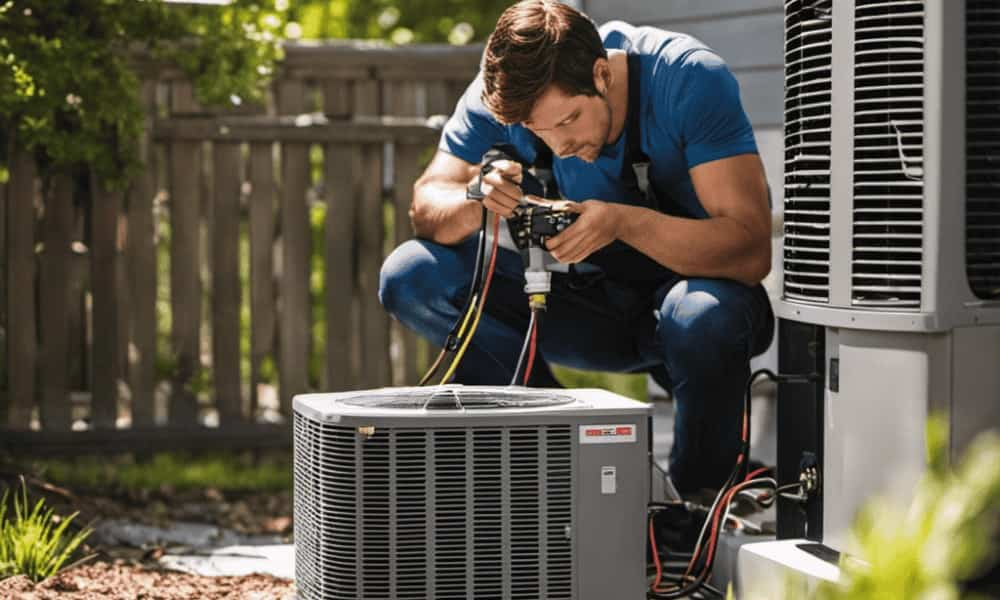
Correct sizing: It’s essential to accurately determine the heating and cooling load of your space. Undersized or oversized heat pumps can lead to inefficient operation and reduced comfort. By correctly sizing the heat pump, you can ensure that it operates at its peak efficiency.
Proper air distribution: Achieving balanced airflow throughout your space is essential for maximizing efficiency. Proper ductwork design and installation, along with regular maintenance, can help optimize air distribution, reducing energy waste and improving comfort.
Quality installation: A well-executed installation is critical for the long-term efficiency and performance of your heat pump. Ensure that the unit is correctly installed, with proper refrigerant charge and adequate airflow, to prevent energy losses and system malfunctions.
Efficiency Benefits of Both
We can maximize the efficiency of our heat pumps and improve their overall performance by implementing proper sizing and installation techniques. Proper sizing ensures that the heat pump is matched to the heating and cooling requirements of the space, optimizing performance and maximizing savings. Oversized or undersized heat pumps can lead to inefficient operation, increased energy consumption, and decreased comfort.
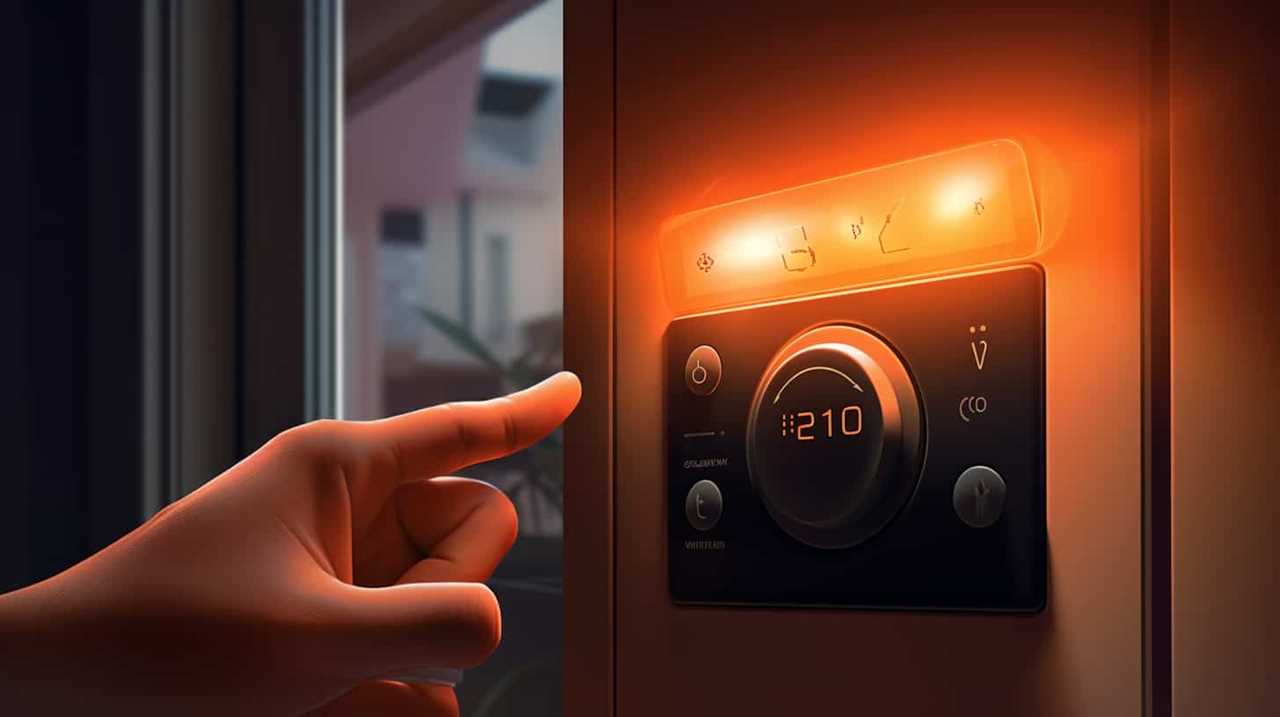
On the other hand, proper installation techniques, such as ensuring correct refrigerant charge, proper airflow, and adequate insulation, further enhance the efficiency of the system. These techniques help to minimize energy losses, reduce system strain, and ensure optimal heat transfer.
By combining proper sizing with correct installation methods, we can ensure that our heat pumps operate at their highest efficiency, providing us with optimal comfort and cost savings.
Transitioning into the next section on regular maintenance and cleaning, it’s important to note that these practices are also crucial for maintaining the efficiency of our heat pumps.
Regular Maintenance and Cleaning
Maintaining and cleaning your heat pump regularly is crucial for its optimal performance and efficiency. By scheduling regular professional maintenance, you can ensure that any potential issues are identified and resolved before they become major problems.

Additionally, there are several DIY cleaning tips that you can follow to keep your heat pump in top shape. Regular upkeep not only extends the lifespan of your heat pump but also helps it operate at peak efficiency, saving you money on energy costs.
Importance of Professional Maintenance
Regular maintenance and cleaning by a professional is essential for boosting the efficiency of our heat pump. Here are the key reasons why professional maintenance is crucial:
Professional maintenance benefits:
Extends the lifespan of the heat pump: Regular maintenance ensures that all components are functioning optimally, preventing premature wear and tear.
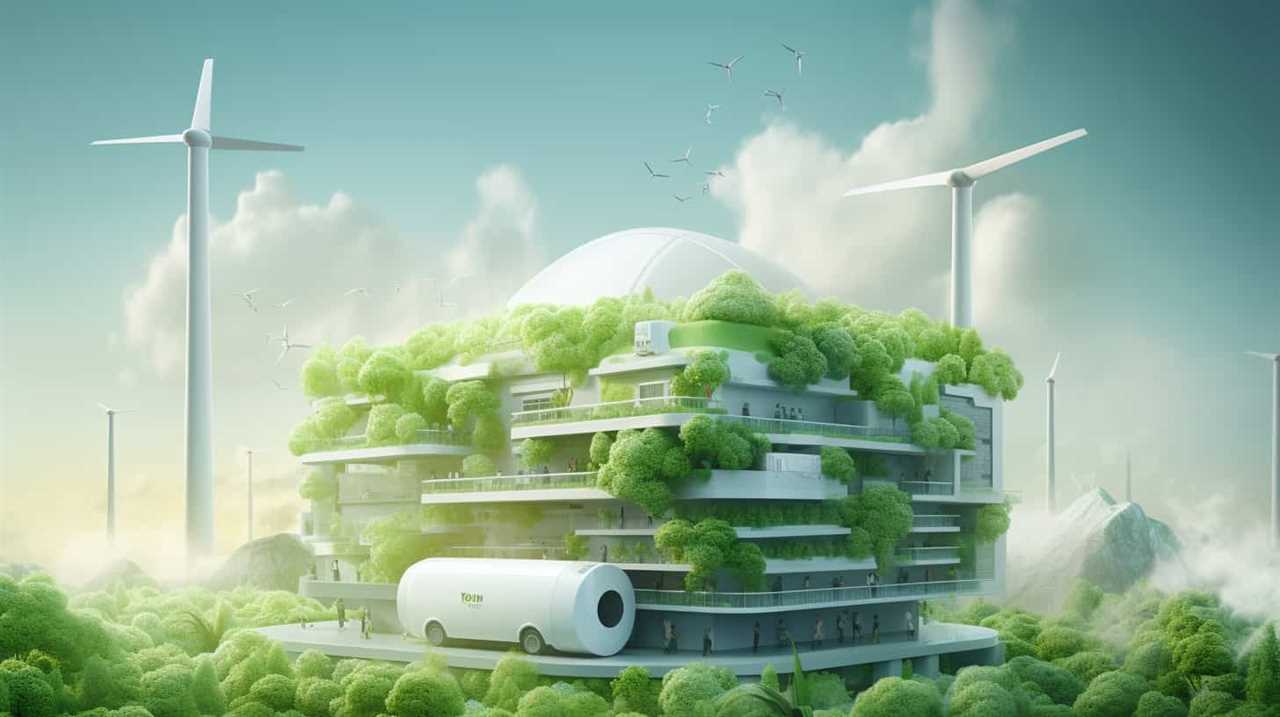
Enhances energy efficiency: A well-maintained heat pump operates more efficiently, reducing energy consumption and lowering utility bills.
Improves indoor air quality: Professional cleaning removes dirt, dust, and allergens from the system, resulting in cleaner and healthier air.
Cost-effective solutions:
Identifying potential issues early: Regular maintenance allows professionals to detect and resolve any potential problems before they escalate, saving you from costly repairs down the line.
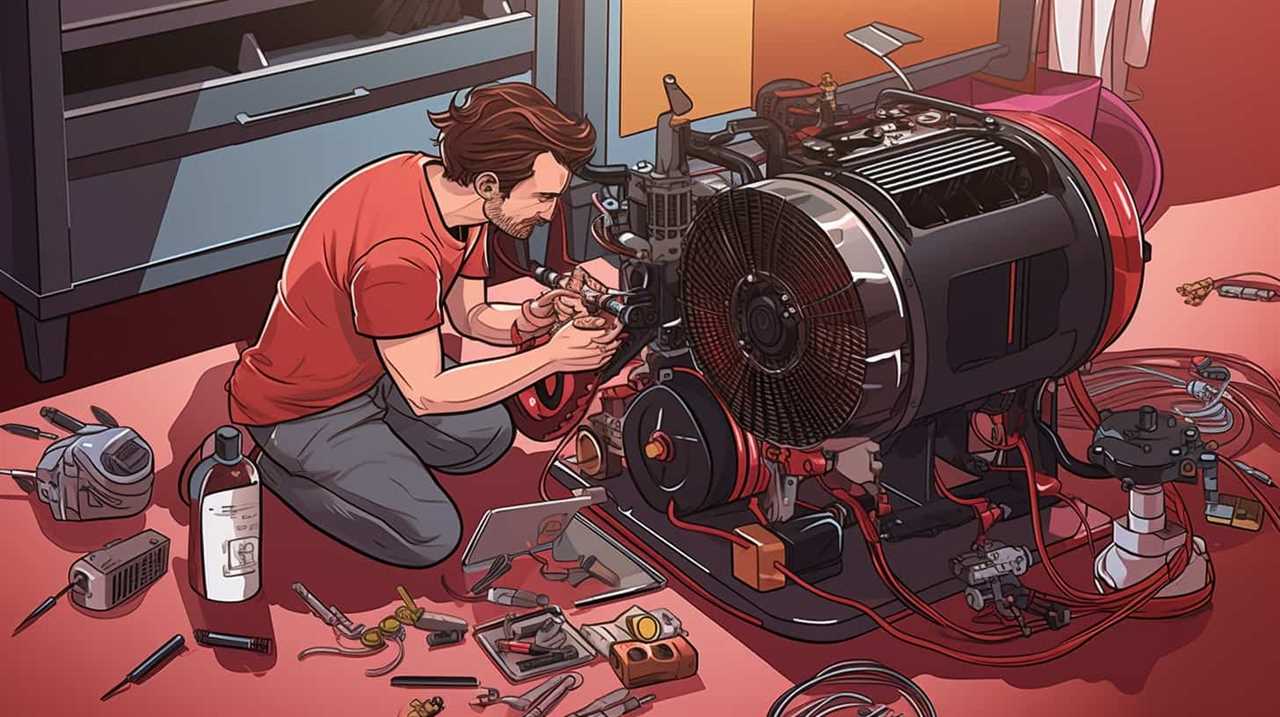
Optimal performance optimization: Professional maintenance ensures that the heat pump operates at its peak performance, maximizing its efficiency and reducing the need for frequent repairs.
DIY Cleaning Tips
One important step in maintaining the efficiency of our heat pump is to perform regular cleaning and maintenance tasks ourselves. DIY cleaning techniques can be cost-effective and help ensure that our heat pump operates optimally.
Regularly cleaning the outdoor unit is essential to remove any dirt or debris that may have accumulated. This can be done by gently spraying the unit with water using a garden hose.
Additionally, cleaning or replacing the air filters every few months is crucial to maintain proper airflow and prevent dust and dirt buildup. Homemade cleaning solutions can also be used for more thorough cleaning. For example, a mixture of vinegar and water can be used to clean the evaporator coils.
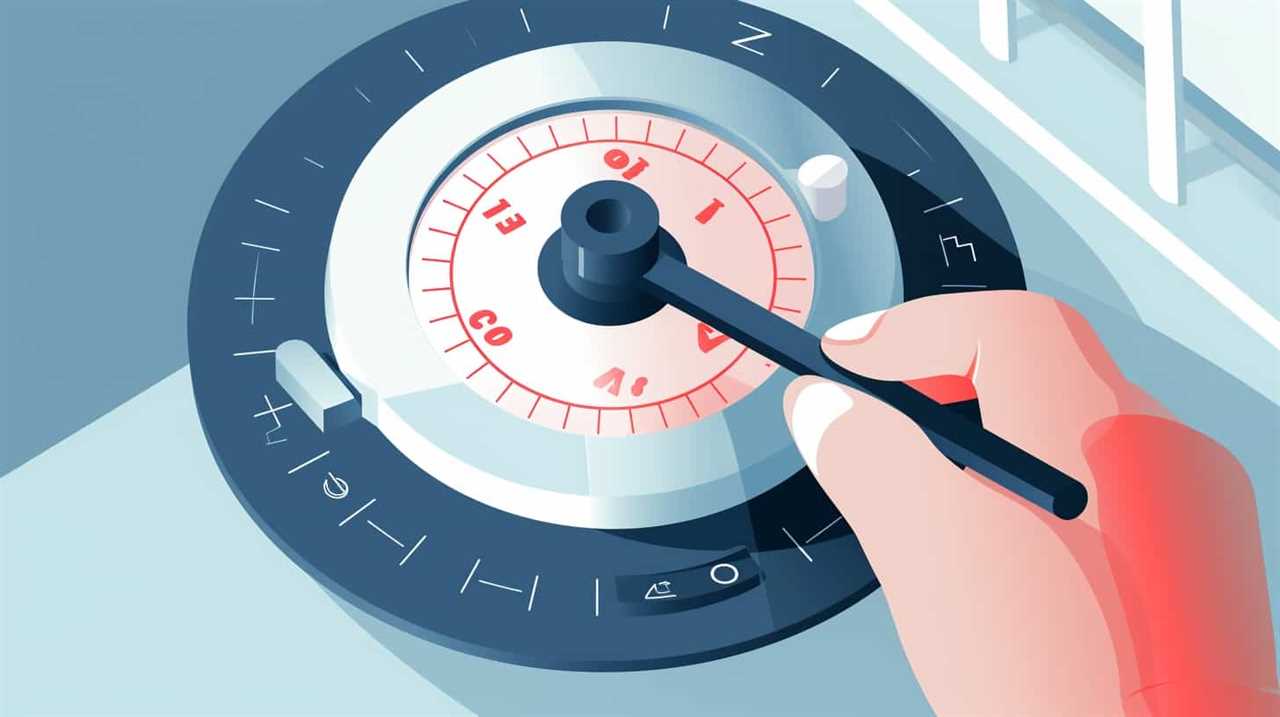
Regular cleaning and maintenance won’t only improve the efficiency of our heat pump but also extend its lifespan.
Benefits of Regular Upkeep
Regular upkeep of our heat pump, including regular maintenance and cleaning, offers numerous benefits for optimal performance and energy efficiency. It’s essential to prioritize regular maintenance to ensure the longevity and effectiveness of our heat pump system. Here are some key benefits of regular upkeep:
- Enhanced Energy Efficiency: Regular maintenance ensures that the heat pump operates at maximum efficiency, reducing energy consumption and lowering utility bills.
- Improved Performance: Routine maintenance helps identify and address any potential issues or malfunctions before they become major problems, ensuring that the heat pump performs optimally at all times.
- Prolonged Lifespan: Regular upkeep extends the lifespan of the heat pump, saving us from the cost and inconvenience of premature replacement.
Additionally, opting for professional maintenance offers several advantages:
- Expert Knowledge: Trained professionals possess the expertise to identify and resolve any underlying issues that may be affecting the heat pump’s efficiency.
- Thorough Inspection: Professionals conduct comprehensive inspections, ensuring that all components are functioning correctly and identifying any potential areas of concern.
- Compliance with Warranty: Regular professional maintenance often fulfills warranty requirements, protecting us from unexpected repair costs.
Investing in regular maintenance has long-term benefits for our heat pump, ensuring optimal performance, energy efficiency, and cost savings.
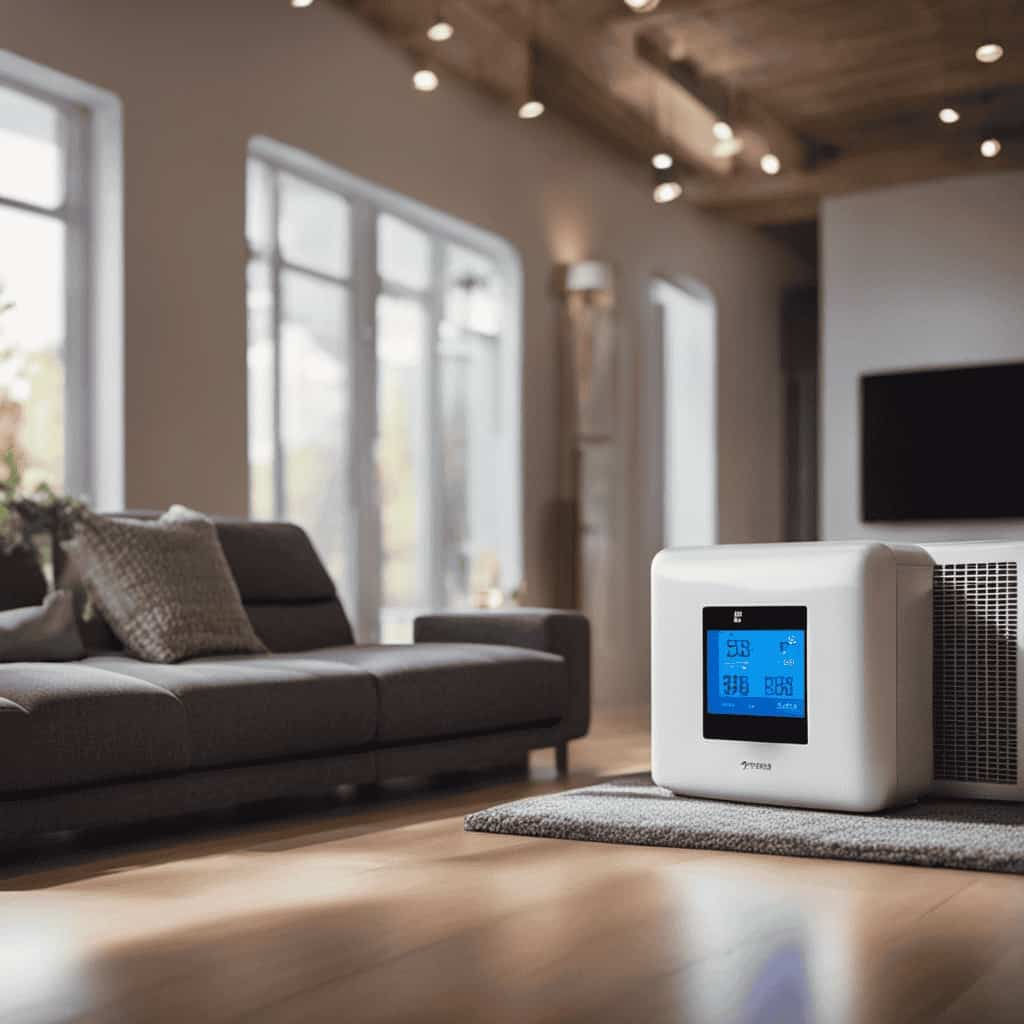
Upgrading to a Programmable Thermostat
We can significantly improve heat pump efficiency by upgrading to a programmable thermostat. By incorporating smart thermostat features and energy-saving programming, we can optimize the performance of our heat pump and reduce energy consumption.
Smart thermostat features include Wi-Fi connectivity, which allows us to control the temperature remotely through a smartphone app. This enables us to adjust the temperature based on our schedule and preferences, ensuring that the heat pump isn’t running unnecessarily.
Energy-saving programming allows us to set different temperature settings for different times of the day, so the heat pump operates at a lower capacity when we’re away or asleep. This minimizes energy usage without sacrificing comfort.
Upgrading to a programmable thermostat provides us with greater control over our HVAC system and helps us save on energy costs.
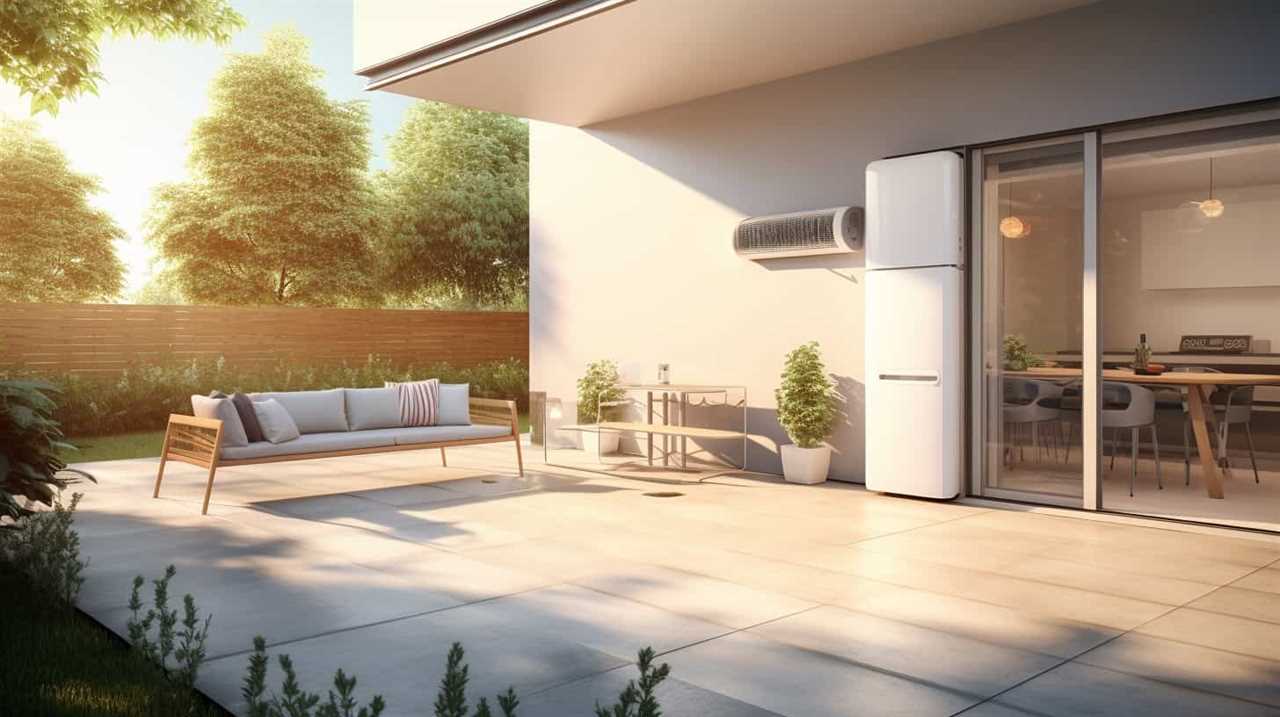
In the next section, we’ll explore the importance of optimizing airflow and ventilation to further enhance heat pump efficiency.
Optimizing Airflow and Ventilation
To optimize airflow and ventilation, we should regularly clean and replace air filters in our heat pump system. This simple task ensures that the air flowing through the system remains clean and free from debris, allowing for efficient operation.
In addition to filter maintenance, there are several other airflow optimization and ventilation techniques that can further enhance the performance of our heat pump system:
- Regularly inspect and clean the indoor and outdoor coils to remove any dirt or debris that may hinder airflow.
- Ensure that vents and registers are unobstructed and not blocked by furniture or other objects.
- Consider installing a ventilator or air exchanger to bring in fresh air and remove stale air, improving overall air quality.
By implementing these airflow optimization and ventilation techniques, we can maximize the efficiency of our heat pump system and enjoy a comfortable indoor environment.

Now, let’s explore another strategy for improving heat pump efficiency: utilizing zone control systems.
Utilizing Zone Control Systems
To enhance our heat pump efficiency, we can utilize zone control systems, which allow us to independently adjust the temperature in different areas of our home. This not only provides personalized comfort but also helps us save energy. By dividing our home into separate zones, we can optimize the heating and cooling in each area based on its individual needs. For instance, we can reduce energy consumption by heating or cooling only the occupied zones and adjusting the temperatures according to our preferences. The following table highlights the benefits of zone control systems and provides energy-saving techniques:
| Zone Control Benefits | Energy Saving Techniques |
|---|---|
| Personalized comfort | Adjusting temperatures based on occupancy |
| Energy savings | Heating or cooling only occupied zones |
| Increased efficiency | Utilizing programmable thermostats |
| Reduced wear and tear | Zoning different areas based on usage |
| Improved indoor air quality | Using zoning to manage ventilation |
Insulating and Sealing Ductwork
By properly insulating and sealing our ductwork, we can significantly improve the efficiency of our heat pump system. Insulating techniques and sealing methods play a crucial role in preventing energy loss and ensuring that conditioned air reaches its intended destination.
Here are three key considerations when it comes to insulating and sealing ductwork:
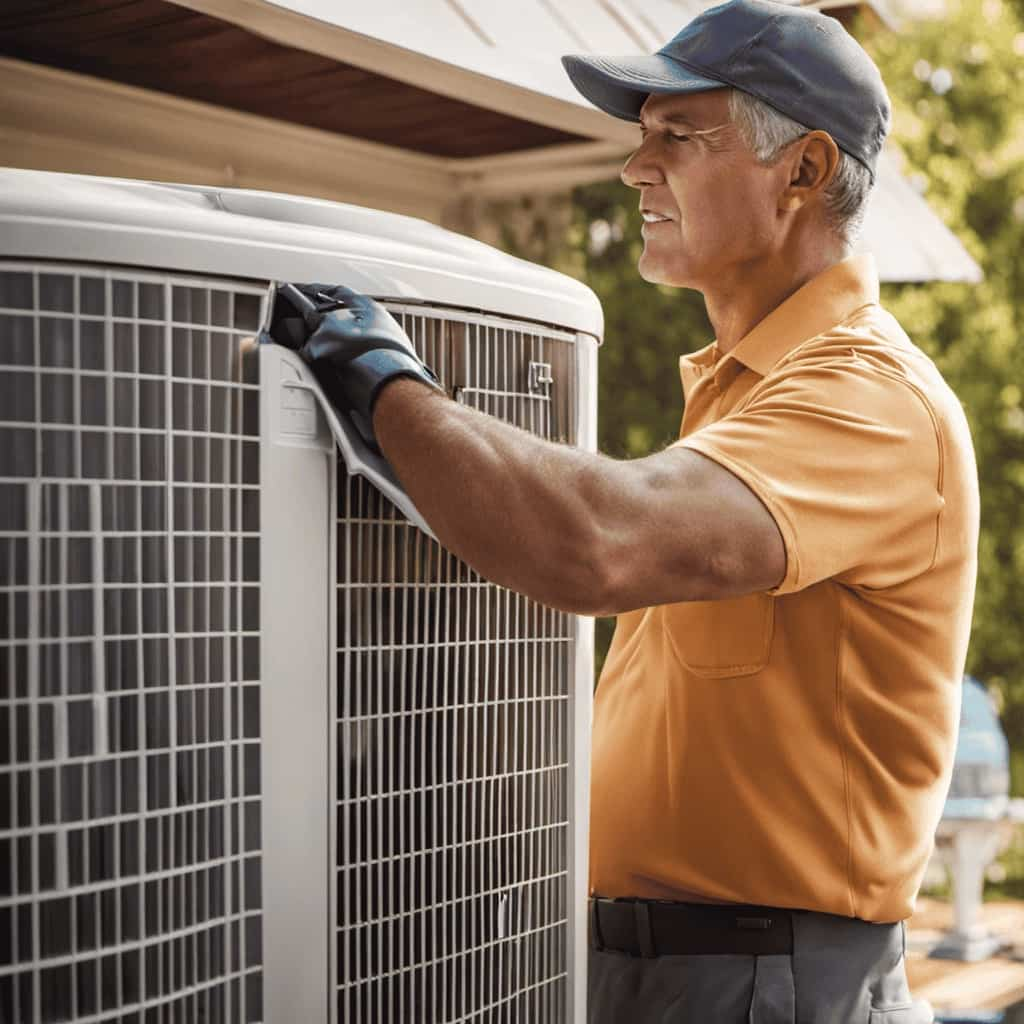
- Proper insulation materials: Using insulation materials with high R-values, such as fiberglass or foam board, can effectively minimize heat transfer and reduce energy loss.
- Sealing duct joints: It’s essential to seal all joints and connections in the ductwork to prevent air leakage. This can be achieved using mastic sealant or metal-backed tape.
- Duct insulation sleeves: Insulating sleeves can be installed around exposed ductwork to provide an extra layer of insulation and prevent condensation.
By implementing these insulating techniques and sealing methods, we can maximize the efficiency of our heat pump system and ensure that conditioned air is distributed effectively.
Now let’s explore the next topic of choosing the right heat pump model.
Choosing the Right Heat Pump Model
When choosing the right heat pump model, there are several important factors to consider.
First, size and capacity are crucial in ensuring that the heat pump can effectively heat or cool your space.
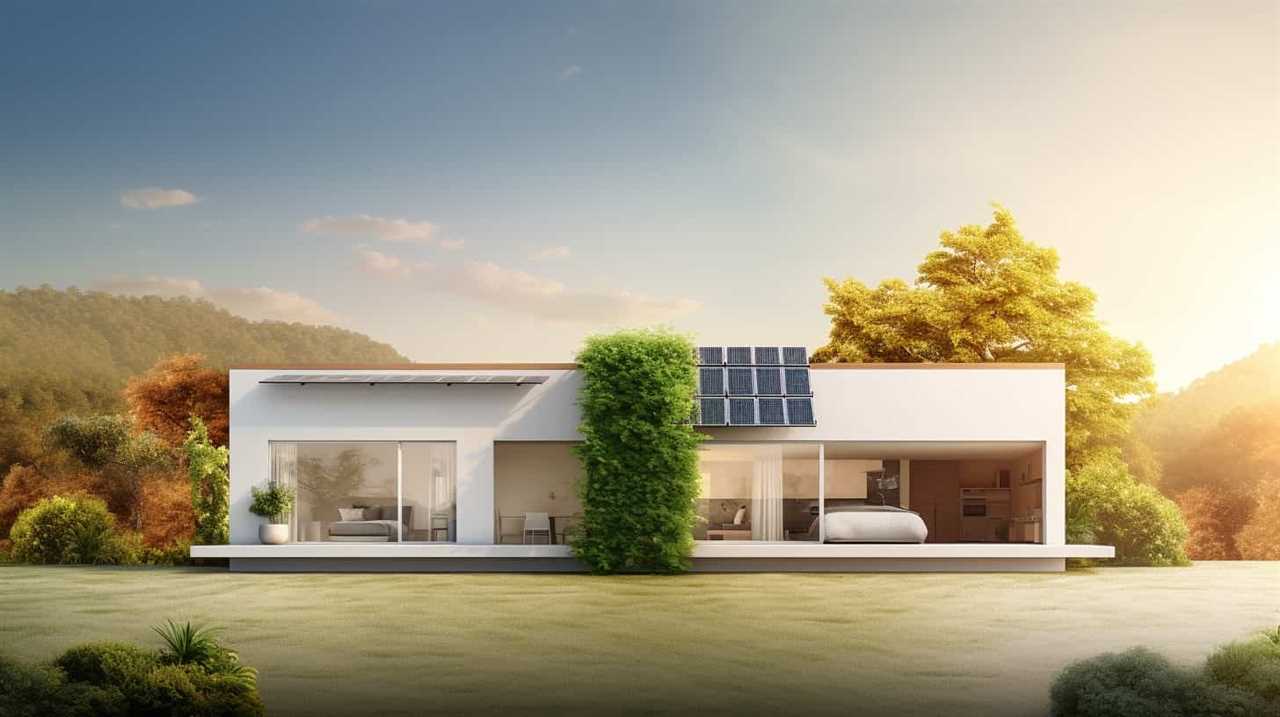
Energy efficiency ratings, such as the SEER and HSPF, should also be taken into account to determine the unit’s energy-saving capabilities.
Lastly, the climate and location of your area should be considered to select a heat pump that’s suitable for the specific temperature and weather conditions.
Size and Capacity
We need to carefully assess our heating needs and select the appropriate heat pump model to ensure optimum efficiency. When it comes to size and capacity, there are a few key factors to consider:
Proper sizing: It’s crucial to choose a heat pump that’s the right size for your home. Oversized units can lead to frequent on/off cycling, while undersized units may struggle to meet your heating demands.

Heat pump capacity: The capacity of the heat pump should match the heating requirements of your home. It’s determined by factors such as the size of the space, insulation levels, and climate conditions.
Energy-saving features: Look for heat pumps with energy-saving features like variable-speed compressors and programmable thermostats. These can help optimize performance and reduce energy consumption.
Energy Efficiency Ratings
Let’s explore the importance of energy efficiency ratings when selecting the right heat pump model for our needs. Understanding energy efficiency is crucial for improving energy performance and reducing our environmental impact.
When choosing a heat pump, it’s essential to consider its energy efficiency rating, which is indicated by the Seasonal Energy Efficiency Ratio (SEER) and Heating Seasonal Performance Factor (HSPF) ratings. The SEER rating measures the cooling efficiency of the heat pump, while the HSPF rating reflects its heating efficiency.
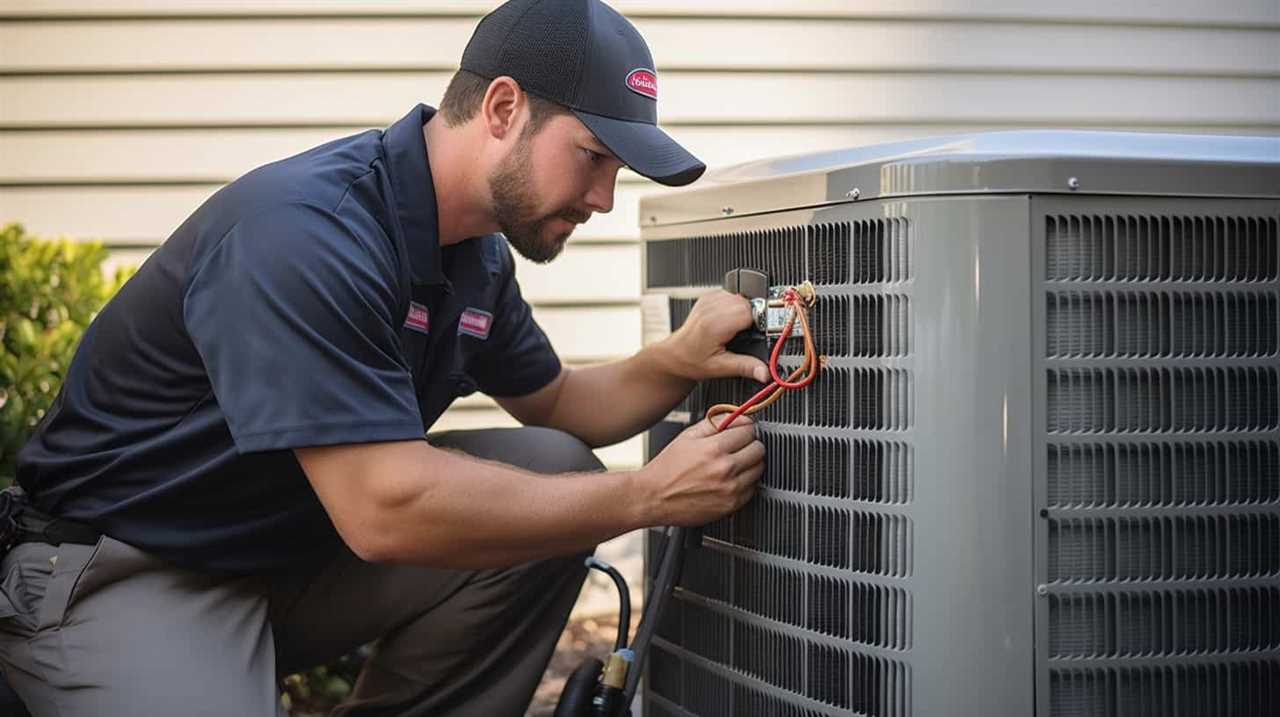
Higher SEER and HSPF ratings indicate better energy efficiency and lower operating costs. It’s recommended to choose a heat pump with a SEER rating of at least 14 and an HSPF rating of 8.2 or higher to ensure optimal energy efficiency.
Climate and Location
How can we determine the right heat pump model for our climate and location?
When it comes to selecting the most suitable heat pump, climate change and geographical factors play a crucial role. To help you make an informed decision, consider the following factors:
Average temperature range: Choose a heat pump model that can efficiently provide both heating and cooling based on the average temperature range in your area.

Humidity levels: If your location experiences high humidity, opt for a heat pump that includes dehumidification features to maintain a comfortable indoor environment.
Elevation and altitude: Higher elevations may require heat pumps specifically designed to handle the unique challenges posed by increased altitude.
Taking Advantage of Energy-saving Features
By utilizing energy-saving features, we can maximize the efficiency of our heat pump.
There are various strategies we can employ to reduce energy consumption and optimize the performance of our system. One effective approach is to utilize programmable thermostats. These devices allow us to schedule temperature adjustments based on our daily routines, ensuring that we only heat or cool our homes when necessary.

Another important feature is the variable-speed compressor, which allows the heat pump to adjust its output based on the heating or cooling demands. This results in more precise temperature control and reduced energy usage.
Additionally, investing in a heat pump with a high Seasonal Energy Efficiency Ratio (SEER) and Heating Seasonal Performance Factor (HSPF) can significantly improve energy efficiency.
Incorporating Renewable Energy Sources
While we can enhance the efficiency of our heat pump through various strategies, one effective approach is incorporating renewable energy sources. This not only helps reduce our carbon footprint but also lowers our energy costs in the long run.
To grab your attention, here are three key points about integrating renewable energy into your heat pump system:

Renewable energy integration: By harnessing the power of solar panels or wind turbines, we can generate clean and sustainable energy to supplement our heat pump’s electricity consumption. This reduces our reliance on fossil fuels and decreases our environmental impact.
Grid connectivity: Connecting our heat pump system to the electrical grid allows us to take advantage of excess renewable energy produced during peak times. This surplus energy can be stored or shared with the grid, ensuring a constant and uninterrupted power supply.
Serving others: Incorporating renewable energy sources not only benefits us but also contributes to the overall well-being of our community. By reducing our energy demands and reliance on non-renewable sources, we actively participate in building a more sustainable future for everyone.
Monitoring and Analyzing Energy Consumption
To effectively optimize our heat pump system, we should regularly monitor and analyze our energy consumption. Energy consumption analysis plays a crucial role in identifying areas of inefficiency and implementing measures to improve overall system performance.
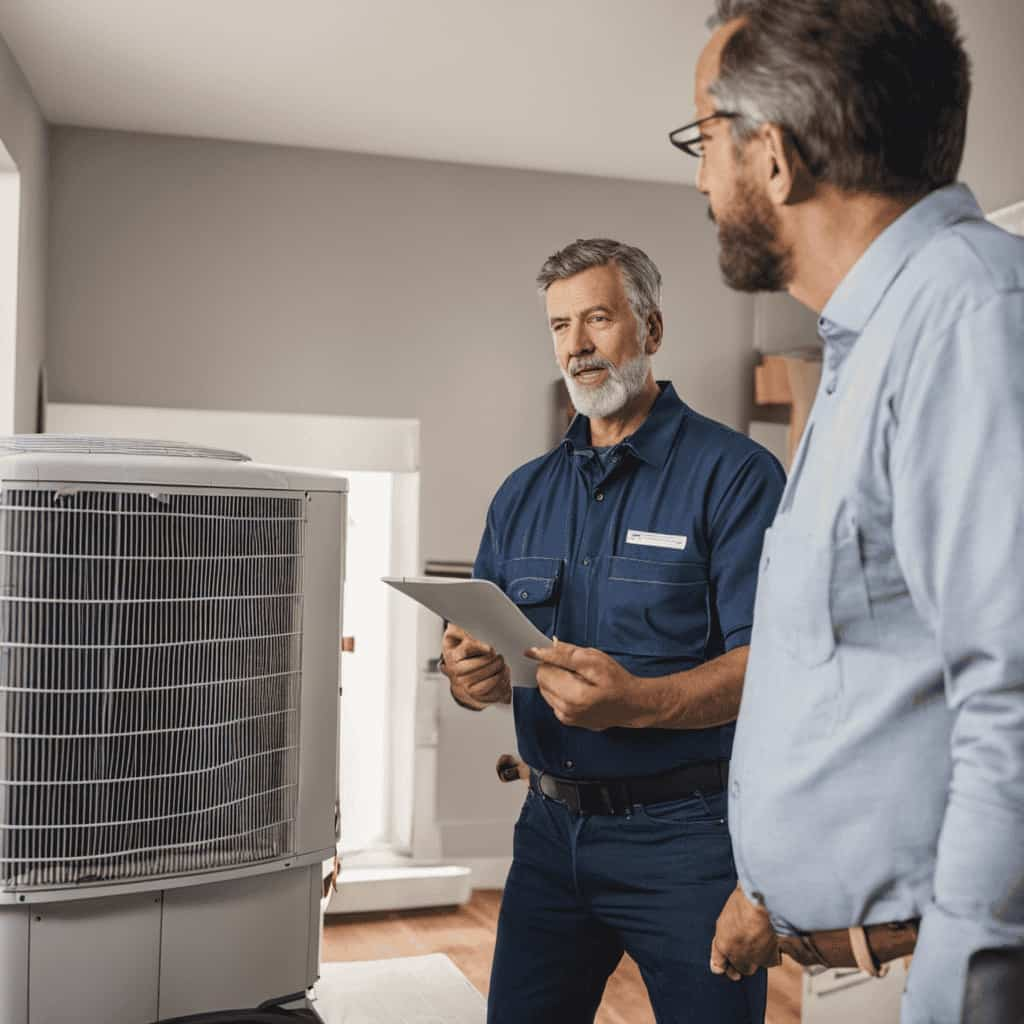
One way to accomplish this is by utilizing smart meter technology. Smart meters provide real-time data on energy usage, allowing us to track and understand our consumption patterns on a granular level. By analyzing this data, we can identify trends, peak usage periods, and potential energy-saving opportunities.
This information enables us to make informed decisions regarding system optimization, such as adjusting temperature settings, optimizing schedules, or implementing energy-saving measures.
Regular monitoring and analysis of energy consumption are essential for maximizing the efficiency of our heat pump system and reducing energy waste.
Frequently Asked Questions
Can I Use My Heat Pump in Extremely Cold Climates?
Yes, we can use our heat pump in extremely cold climates. However, it is important to consider heat pump efficiency in extreme cold climates and regularly maintain heat pump filters for optimal performance.

How Often Should I Clean or Replace the Air Filters in My Heat Pump?
Regular filter cleaning is crucial for heat pump maintenance. It improves efficiency and ensures clean air circulation. We recommend cleaning or replacing the air filters every 1-3 months, depending on usage and air quality.
Are There Any Government Incentives or Rebates Available for Upgrading to a More Energy-Efficient Heat Pump?
Yes, there are government incentives and rebates available for upgrading to a more energy-efficient heat pump. These programs offer financial benefits to encourage the use of environmentally friendly technology.
What Is the Average Lifespan of a Heat Pump?
The average lifespan of a heat pump depends on various factors, such as regular heat pump maintenance and proper care. However, signs of heat pump failure, such as reduced efficiency and increased energy consumption, may indicate the need for replacement.
Can a Heat Pump Be Used for Both Heating and Cooling Purposes?
Yes, a heat pump can be used for both heating and cooling purposes. This dual function feature allows for efficient temperature control in a cost-effective manner, improving overall heat pump efficiency.
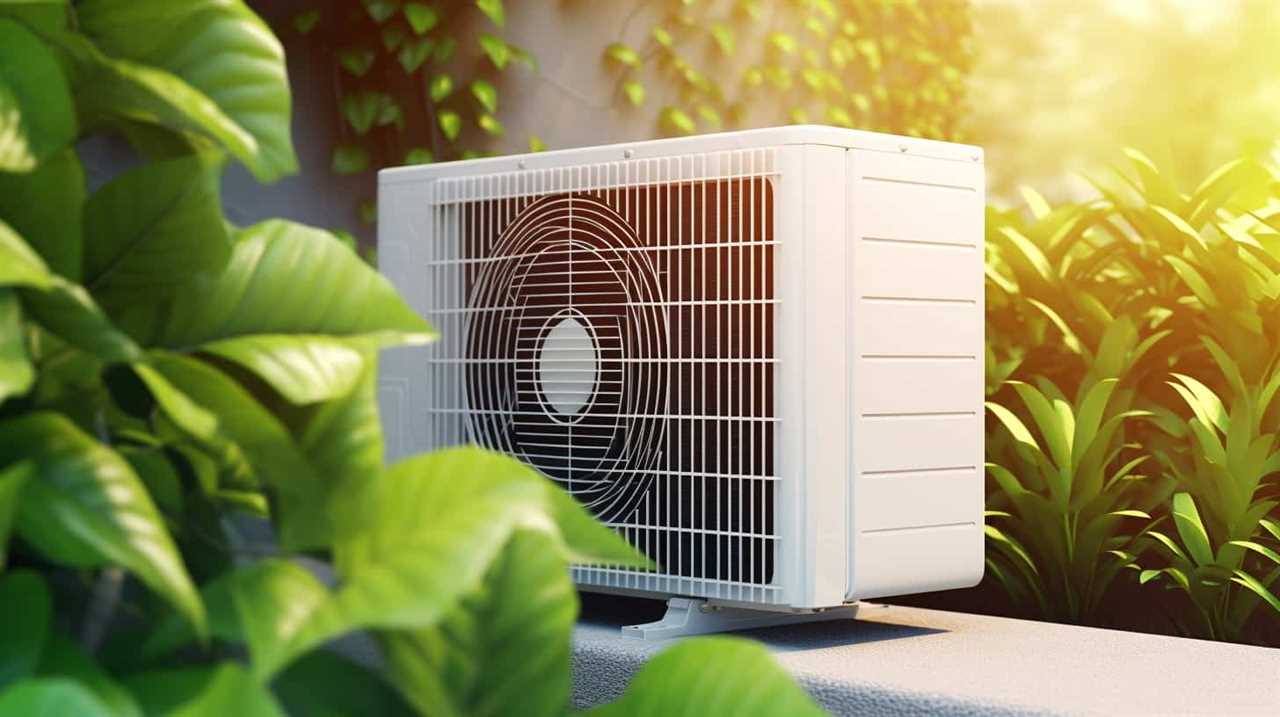
How Can Boosting Heat Pump Efficiency Contribute to Sustainable Climate Control?
Boosting heat pump efficiency has several key benefits of heat pumps, especially when it comes to sustainable climate control. Higher efficiency means less energy consumption, resulting in reduced greenhouse gas emissions. This contributes to combating climate change and creating a greener future. Additionally, improved efficiency translates into cost savings for homeowners, making heat pumps an environmentally and economically wise choice for climate control.
Conclusion
In conclusion, by implementing these 15 strategies for boosting heat pump efficiency, you’ll witness a mind-blowing transformation in your energy consumption. Your heat pump will become a sleek, energy-saving powerhouse that will leave you in awe of its performance.
From understanding efficiency ratings to incorporating renewable energy sources, every step ensures maximum efficiency and savings.
So don’t wait any longer, unleash the full potential of your heat pump and experience the extraordinary benefits it has to offer.
